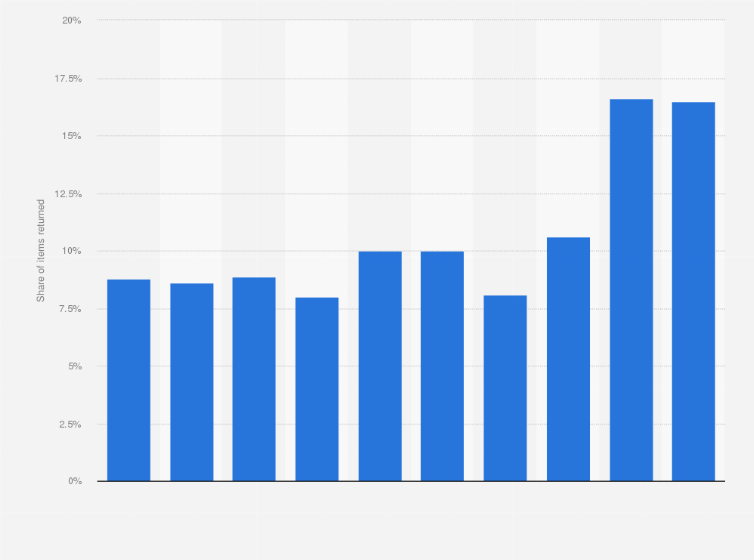If you are like the vast majority of American consumers, you’ll be heading to a store this January to return an item—or several items—that were less than satisfactory. As a packaging supply company, we were curious to know exactly how much Americans return throughout the holiday season each year. Here are some of the most interesting facts we uncovered through our research into holiday returns.
U.S. consumers bought more in 2023, not less.
This fact surprised us, but it’s true. Despite rising costs of groceries, housing, and other necessities, U.S. consumers still spent about 3.1% more this holiday season than they did last year. That info comes from MasterCard SpendingPulse, which measures online and retail sales across all forms of payment (excluding automotive sales).
This latest figure represents a return to pre-pandemic spending levels, according to the National Retail Federation (NFR). And it’s actually lower than 2021 and 2022 spending, when sales jumped by about 12% each year.
This season’s holiday returns might add up to $173 billion.
According to returns services provider Optoro, U.S. consumers may make up to $173 billion worth of returns from Thanksgiving 2023 to the end of January 2024. About $80 billion is estimated to come from online shopping alone. Those numbers aren’t too far off from last year’s numbers; during the same time frame in 2022, U.S. consumers returned $171 billion worth of merchandise.
Americans returned $816 billion in merchandise in 2022.
The above figure, $171 billion, only included returns made from November to January. But the total amount of returns Americans made in 2022 is a whopping $816 billion, according to the National Retail Federation. That represents about 17% of retail purchases (both in-store and online).
The percentage of returned items has skyrocketed in recent years.
Retail returns jumped to an average of 16.6% in 2021 and 16.5% in 2022, compared to a 10.6% average in pre-pandemic years. This chart from Statistica helps illustrate how much more Americans are returning lately—and why many merchants are beginning to tighten up their return policies.
The reason for the jump? Most sources attribute it to a buying trend called “bracketing,” or when consumers purchase items in several sizes and colors, and ship back what they don’t want.
It costs about $30 to process a return for a $100 item.
Shipping, warehousing, and restocking a returned item isn’t cheap. Optoro found that it typically costs a company 66% of the price of a product to process a return. Retail firm Inmar Intelligence estimates it costs merchants about $27 to handle a return for a $100 online order.
Only about 30% of all returned items are resold.
The majority of returned items are never returned to their physical or digital place or origin. Many are resold on secondary markets, like eBay or ThredUp. Mega-retailers Amazon, Target, and Walmart try to recoup their losses on their own websites, through Amazon Warehouse, for instance. Many products end up in liquidation warehouses, where they are resold at a discount. About 25% of all returns are destroyed, according to Tobin Moore, CEO and co-founder of Optoro. Most are placed in a landfill or burned.
Returned inventory creates 9.5 billion lbs. of landfill waste a year.
According to Optoro, returned inventory amounts to 9.5 billion pounds of landfill waste annually, as much as 10,000 fully-loaded Boeing 747s. And speaking of travel, U.S. returns generate 16 million metric tons of carbon emissions during their reverse journey.
How to help decrease holiday returns
At this point, if you’re a small business owner, you’re probably wondering at this point what you can do to help stem the massive tide of returns. We dive into this topic in more detail here, but for the time being, here are a few tips on keeping returns to a minimum.
- Describe products with accuracy. If you are selling your products via an online platform, make sure that your photos accurately display the item’s color and condition. Use high-quality photos that capture as much detail as possible, and use minimal retouching.
- List as much detail as possible. If you are selling products online, make sure that all information about the product is easily accessible. List the measurements and materials used, especially for clothing items. If you sell clothing, try portraying them on models of many different sizes.
- Use adequate, quality packaging materials. Using cheap, flimsy materials will only cost you more in the long run. Use enough quality bubble wrap, foam, or paper fill to ensure your items arrive safely.
- Encourage reviews. If you are marketing your product on your website or social media pages, incentivize customers to post pictures of themselves wearing or using the product. This can help potential shoppers decide if the item is right for them. Don’t be afraid of negative feedback, as long as it’s politely worded.
Get more packaging news & tips from SSI Packaging
We hope that this blog has helped inform you on the current state of returns in America. For more advice on reducing your own holiday returns, feel free to check out our blog. Thanks for reading, and happy new year!


